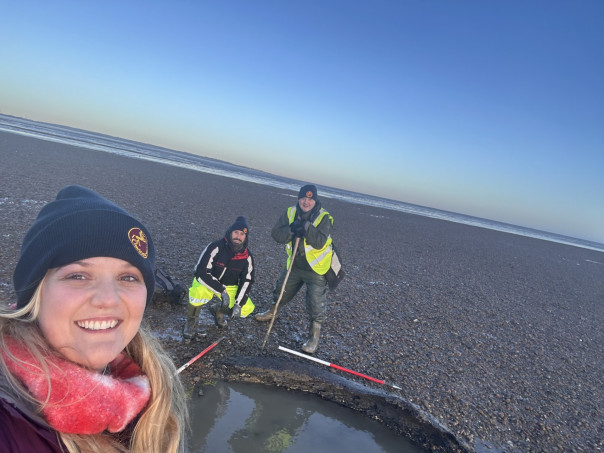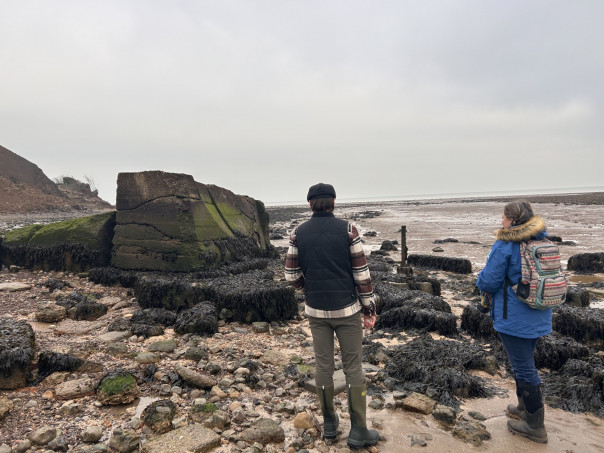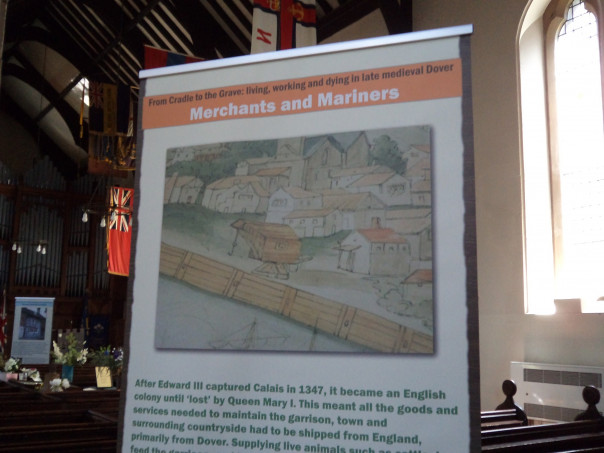This week it is great to be able to feature one of the CKHH’s Kent History Postgraduates. Grace Conium Parsonage recently submitted her doctoral thesis and has just started in a post with MOLA (Museum of London Archaeology) – many congratulations Grace!
In many ways her new position can be seen as a development of her PhD entitled ‘Shifting Sands: Kentish Coastal Communities in Transition’ which was a Collaborative Doctoral Partnership between MOLA and CCCU. Furthermore, she worked extensively with the CITiZAN project because her research focused on the impacts and legacy of community archaeological projects along Kent’s east coast. Her case studies concerned projects being undertaken at Sandwich Bay, Folkestone and Dover where, among other things, she conducted interviews with community archaeologists and volunteers. Her aim was to demonstrate the wide range of project legacies that community archaeology can achieve. Additionally, she has been involved in the activities carried out by Timescapes Kent, which is a community archaeology group that undertakes research to develop knowledge and understanding of the history of Whitstable and surrounding villages.

As part of the new Coasts in Mind project, Grace is the Project Officer for the Swale Estuary Region, where she will be working with the local communities across the Swale region to capture their memories and stories of the changing coastline. The ‘Coasts in Mind’ project has been awarded a generous grant from The National Lottery Heritage Fund and Lloyd’s Register Foundation to work with local communities mapping a century of change in Sefton (Merseyside), Poole Harbour (East Dorset), the Taw-Torridge Estuary (North Devon), and the Swale Estuary (North Kent).
The plan is that over the next three years the ‘Coasts in Mind’ team will run a variety of talks, workshops, training sessions, memory walks, and more, working with local people to co-curate a Community Archive on a new online mapping platform developed by HUMAP. The idea is that by creating a community archive of local knowledge, memories, and archival records, the ‘Coasts in Mind’ project team will help communities demonstrate the impact of climate change. The material collected will offer a great resource that can be used by local groups, researchers, and local and national policymakers, to inform future coastal management strategies and increase public awareness of coastal change. Furthermore, Grace and her colleagues intend to create connections between local people and community groups, with the aim of reducing social isolation and helping communities become more resilient, so they can face the future of coastal change together. Consequently, Grace is extremely excited to be part of this new initiative, and she is looking forward to working with the local communities across the Swale region to capture their memories and stories of the changing coastline.

As her role develops, Grace will provide updates that will feature in the CKHH blog – so please watch this space!
Next week I’ll provide an update on the Tudors and Stuarts History Weekend and if you don’t know about it here is the link: https://ckhh.org.uk/tudors-stuarts but for now I thought I would mention that I was at a planning meeting for the ‘Dover at Night’ event that will be happening in Dover on the evening of Friday 7th March. Kieron Hoyle and I will be representing the CKHH in St Mary’s church and as well as talking to people about the history of the Maison Dieu in medieval and Tudor times, we’ll have our pop-up banners on 6 aspects of life in medieval Dover. For the theme of the River Dour, we have copies of an information sheet that people can take away that’s entitled ‘Gone (freshwater) fishing – in medieval Dover’ featuring the fish caught in the river in medieval and hopefully modern times. We also have information sheets for people on medieval Dover more generally under the title ‘From Cradle to Grave: living, working and dying in late medieval Dover’. Kieron has been organising the creation of a model of the Pent and we’ll have a family-friendly fish colouring activity. For those living in Dover and the surrounding area, we’ll be delighted to see you that evening.

Also in St Mary’s church will be ‘Kent Maps Online’ under the auspices of Michelle Crowther and Professor Carolyn Oulton and they will be showcasing Dover’s literary history on an interactive map following the course of the River Dour. Dr Diane Heath is similarly bringing her ‘Medieval Animals’ to Dover. More details about the full programme will be available very shortly and trail sheets will be available from many outlets in Dover from the 22nd February, as well as freely to download at www.maisondieudover.org.uk/events please look out for these.
Finally for this week, I just thought I would let you know that the manuscript of the Kent Maritime Communities book, entitled Kent and Europe, 1450‒1640: Merchants, Mariners, Shipping and Defence has been accepted by Boydell as ready for publication. This book involving Professor Craig Lambert, Drs Robert Blackmore and Gary Baker (University of Southampton) and me means we are now at the stage of sorting out permission for the cover image, always an exciting moment. Consequently, we are on course for a book launch in Canterbury in the autumn but before that on Saturday 10 May the project’s website will be launched at Dover Museum. Again, I give more details once finalised but please do save this date because it is a very exciting development.
 Centre for Kent History and Heritage
Centre for Kent History and Heritage Sheila Sweetinburgh
Sheila Sweetinburgh 1491
1491

